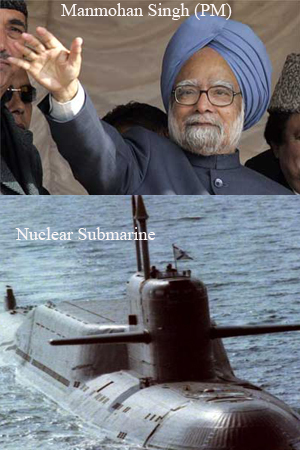PM to launch country’s first nuclear-powered submarine

Visakhapatnam July 25 :-
The long cherished desire of India possessing an indigenous nuclear submarine will finally materialise when Prime Minister Manmohan Singh will launch the country’s first nuclear-powered submarine, the INS Arihant, on Sunday (July 26), at Visakhapatnam.
The project to build the Advanced Technology Vessel (ATV) is the effort of three decades of planning and a decade of dedication to complete the project. Five such submarines are to be built.
Still it is not yet clear to which class this nuclear submarine belongs. The guess that it would be a Yasen class Russian design has now been replaced by recent speculation that describes it as belonging to the Antey (Nato’s Oscar) class.
Efforts to design a nuclear reactor for naval purposes started in the 1970s and 1980s but nothing prominent has come out of it. Then the authorities sought the cooperation from the Russians. According to reports, the Russian design bureau Rubin helped to develop the submarine’s 190-megawatt Pressurised Water Reactor (PWR). The contribution of Indian scientists to the ATV was not much but quite significant in its own way.
The idea of building two Shchuka-B (Akula) class nuclear submarines in Russiain 2001 failed to click. In the following year 2002, an Indian crew was trained in Russia to man nuclear-powered submarines.
In 1991 when the lease of the Russian Charlie-I class nuclear submarine (INS Chakra) to India ended then the present ATV programme take the shape. Defence experts are of the opinion that the ATV is almost a replica of the newest Russian attack submarine of the Severodrinsk class.
The ATV will carry 16 Sagarika class cruise missiles.
Most nuclear submarine reactors of this variety use uranium as fuel enriched to 21 to 45 per cent. Refuelling may be done once in three or five years of active duty. The submarine needs to surface only for food supplies, crew replacement and maintenance.
Areas of operation by the Indian Navy include the Arabian Sea, the Indian Ocean and the Bay of Bengal. These waters include important Sea Lines of Communication Chokepoints (SLOC) like the Straits of Hormuz, Bar El Mandeb and the Malacca Straits.
With the launch of the Arihant, India will join the elite club of five countries that operate nuclear submarines: the US, Russia, the UK, France and China. This will add a very significant force multiplier factor to India’s warhead stockpile to counteract the counter-force potential of a hostile China.
It gives India a credible second strike capability to deter a pre-emptive strike. In fact, Chinese nuclear doctrine considers nuclear submarines very important for its strategic taskforce. Peng Shilu, the designer of China’s first naval nuclear reactor, has said that “in future the most critical naval asset will be the nuclear submarine”.
Richard Sharpe of Jane’s Fighting Ships, the very reputed military journal, commented that the ATV puts the Indian Navy in a different league. “You could call it the ace of spades in the pack of maritime capability,” he wrote.



